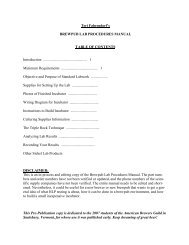New Lab Manual-2010SEP06.pub - Teri Fahrendorf
New Lab Manual-2010SEP06.pub - Teri Fahrendorf
New Lab Manual-2010SEP06.pub - Teri Fahrendorf
Create successful ePaper yourself
Turn your PDF publications into a flip-book with our unique Google optimized e-Paper software.
SPECIAL TECHNIQUES<br />
TO MOUTH PIPETTE: Open the beer sample test tube first.<br />
Turn a pipette so the cotton plug end is up. Take the wrapper off the pipette. Discard the wrapper.<br />
Hold pipette with right thumb and index finger. (If you're a lefty, you'll have to translate<br />
this yourself.) Be aware of the other end of the pipette so that you don't touch it to anything.<br />
Put the pipette into the beer, being careful to avoid any sediment at the bottom of the test tube.<br />
Pick up an HLP tube with your left hand. Wrap your right pinky around the cap, and twist tube<br />
with your left hand to get the cap off.<br />
Put both the plug-end of the pipette, and your right index finger into your mouth. Suck the beer<br />
up slowly to the 1 ml level, avoiding the sediment, and then put your finger over the end of the<br />
pipette so the beer doesn't slip out. The beer should stay put until you barely remove your finger<br />
to release the beer into the HLP tube. As long as you suck and don't blow, the cotton plug<br />
should protect the beer sample from your germs.<br />
Before releasing the beer, check the level of the beer on the pipette graduations, beneath the<br />
foam level. If this 1 ml pipette was exactly full, it would read 0. If it was nearly 3/4 full, it<br />
would read .3. (The test tube graduations seem upside-down.) If you add .5 to the beer level<br />
reading, the answer is the level the beer should be at after you release exactly .5 ml. The best<br />
way to not let the beer get away from you, is to watch the ending beer level reading for the approach<br />
of the beer. It is much harder to watch the beer itself - a moving target.<br />
Discard the pipette, and reseal the test tube. Tip the test tube upside-down twice to mix. If you<br />
haven’t already, mark the test tube cap with the grease pencil to identify the beer sample, and<br />
put the test tube back in the HLP rack (A third test tube rack is very handy here, but I am trying<br />
to save you money!)<br />
PIPETTING HELP…<br />
If the above mouth pipetting procedure seems too difficult to master, you may want to purchase<br />
the optional Pipette Filler, listed on the supply page. I have never used a Pipette Filler, so you<br />
will have to read the directions on how to use it.<br />
WHAT IS “DRY LABBING”?<br />
I learned the name of this unfortunate technique while on my 2007 road trip. I once employed a<br />
brewer who faked his labwork. He put HLP test tubes straight into the incubator without any<br />
beer in them. Of course nothing grew, so it looked like his tanks were always bacteria-free.<br />
When he left my employ, I discovered he had a low-level contamination in all the fermenters<br />
and servers, so I spent six months bringing in new yeast and acid washing every tank after<br />
every batch. Faking labwork and filling out perfect paperwork is called “dry labbing.” If your<br />
employees will be doing this labwork and not you, you must require that they mark the date,<br />
with a Sharpie permanent pen on the test tube, not on the cap, each time. Only then can you be<br />
sure they at least have to brew up fresh HLP each time. However, I hope they are diligent, and<br />
dedicated employees, and that they appreciate the reason for labwork as much as you do!<br />
13



